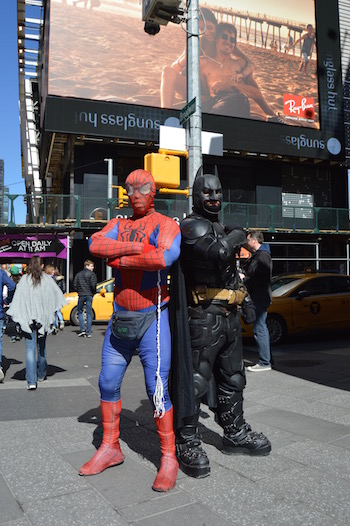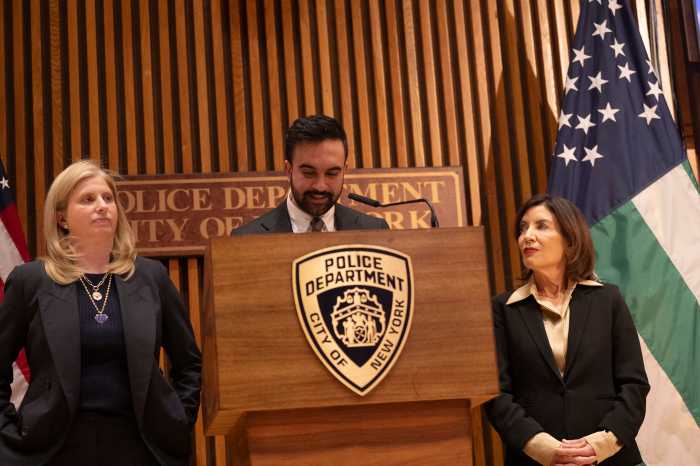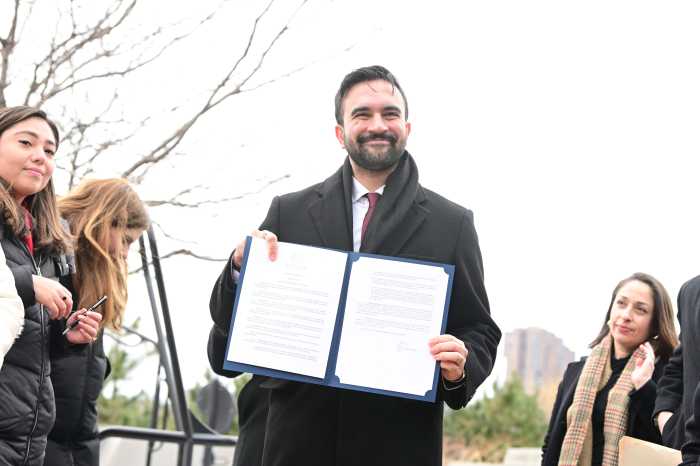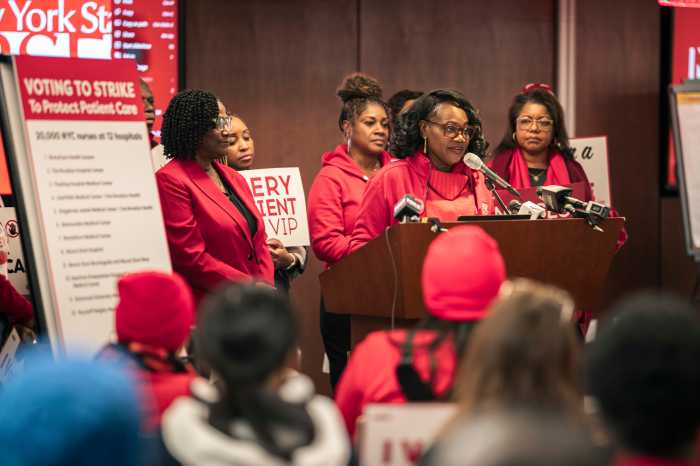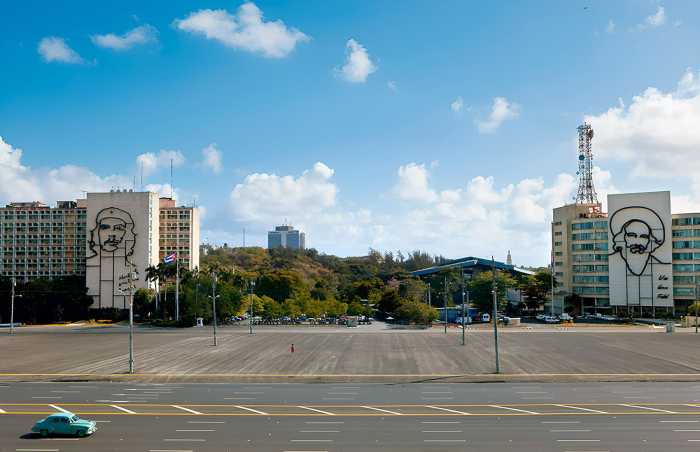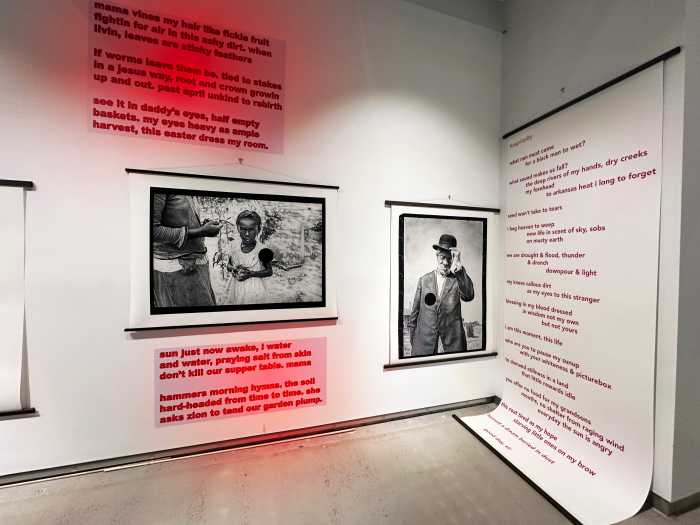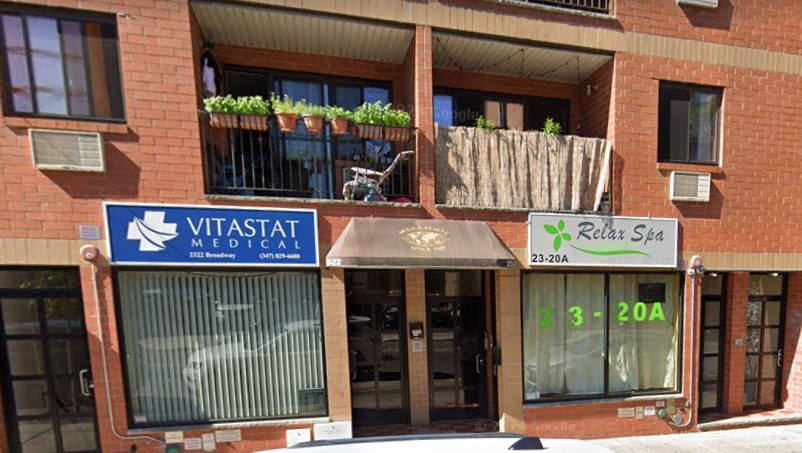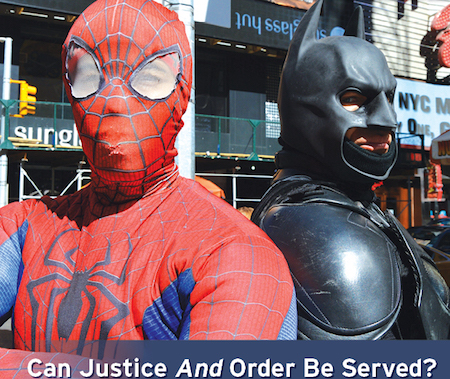
BY JACKSON CHEN | When they’re not fighting crime in their respective comic book universes, the teenage web slinger joins the grizzled protector of Gotham City in entertaining tourists in Times Square with marvelous photo opportunities.
Down the way, more flocks of cartoon characters are hanging around the chaotic corners of the Crossroads of the World. As hordes of people course through Times Square, the costume-clad crews connect with the many tourists looking for a goofy photo with an iconic backdrop.
After they’ve snapped their shots with the mishmash of pop culture icons, tourists often end their interaction with tips, even though many signs and nearby police officers warn they’re not obligated to.
Spider-Man, whose real identity is Abdelamine el-Khezzani, is careful to offer up the preface that he works off tips before striking a pose alongside children, slinging a makeshift spider web at the camera and declaring “Justice is served!”
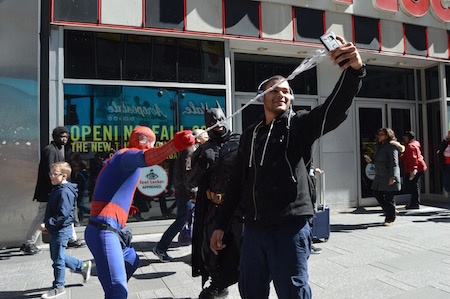
For Spider-Man and his cohorts, however, justice hangs in the balance as the City Council looks at legislation intended to bring some order to the disorganized scene of wandering sightseers and tip-hungry characters.
“It’s chaotic, difficult to pass through, and increasingly unpleasant for tourists and New Yorkers alike,” said Councilmember Dan Garodnick, whose largely East Side district captures a portion of Times Square. “We want to both preserve the quirkiness and edge of Times Square while also allowing people to avoid the chaos if they want to.”
After incidents of “aggressive panhandling” popped up on the media’s radar and became a commonplace storyline, a lengthy public task force process has culminated in Councilmember Corey Johnson’s Intro 1109, announced on March 9.
“Times Square is known around the world for its bustling, quirky, and slightly chaotic atmosphere,” Johnson, a West Sider who shares Times Square with Garodnick, said in a written statement. “But when certain individuals cross the line and harass, swindle, and take advantage of pedestrians, the city must take action.”
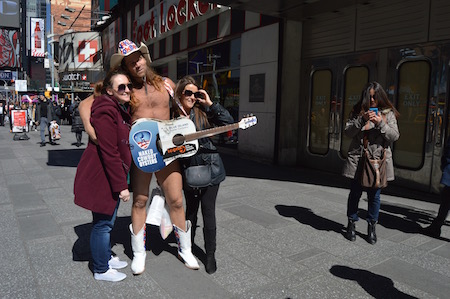
Under Johnson’s bill — co-sponsored by Councilmembers Garodnick, Ydanis Rodriguez from Upper Manhattan, Ritchie Torres of the Bronx, and Brad Lander of Brooklyn — the Department of Transportation would be given authority to designate pedestrian plazas through consideration of an area’s need for open space, its ability to be maintained, and its surrounding environment.
The bill also gives the DOT’s commissioner, currently Polly Trottenberg, the ability to establish general rules of conduct for pedestrian plazas throughout the city and specific regulations tailored to certain plazas. Times Square is clearly what the bill has in mind in terms of tailored regulations, though it is not named specifically in the legislation.
Though overall authority will reside with the DOT as the designating body, community boards, councilmembers, borough presidents, and non-profit organizations can submit proposals for pedestrian plazas.
The costumed characters and other performers who fill Times Square worry that the Council effort could compromise their First Amendment rights along with their livelihoods.
“This is a public space, we are free people,” said Khezzani, the spirited Spider-Man of Times Square. “We show our freedom of expression in this public space.”
Khezzani, who’s been a costumed character for 12 years, said regulating a public space where everyone has freedom of speech and expression makes no sense.
Joining Spidey, the Times Square’s Dark Knight — aka José Escalona-Martinez — said no new regulations should be able to override his constitutional rights to express himself.
“This is a public place which allows any cartoon characters, any tourist to walk freely, dressed in whatever they want to dress,” Escalona-Martinez said.
While they’re adamant on protecting their freedom of expression, the heroic duo acknowledge there have been problems with some costumed characters.
According to several news outlets, incidents have ranged from Junior Bishop — also dressed as Spider-Man, as well as the Incredible Hulk — facing charges of felony assault on a police officer, disorderly conduct, and aggressive panhandling to infighting between Minnie Mouse and Hello Kitty over tips and a trio of Minnie Mouse, Cookie Monster, and Olaf from Disney’s “Frozen” allegedly boxing in a tourist until they paid up.
The NYPD’s Times Square arrest records include addresses from the far away Galactic Empire, the friendly Sesame Street, and even Ellis Island, when Darth Vader, Elmo, and the Statue of Liberty were all slapped with charges of aggressive panhandling.
“When more characters came into the square, there’s where the problem started to evolve,” Khezzani said. “Some characters, they get greedy, then police start getting involved and people get arrested.”
He added that the recent visibility of the desnudas, or topless women who are costumed in body paint, have stoked demands that the city better regulate behavior in Times Square.
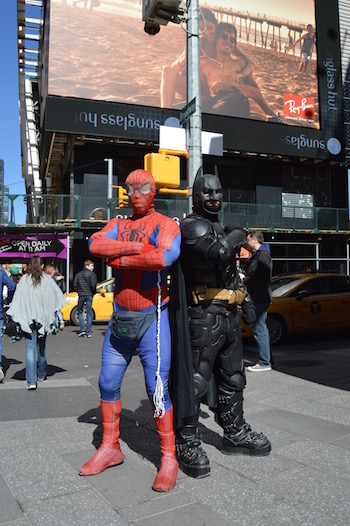
With so much rowdiness unfolding in public view, the Council worked with city agencies and the Times Square Alliance, the area’s business improvement district, to figure out a solution to what was widely seen as a growing menace.
Last August, Mayor Bill de Blasio created a task force to address concerns voiced by Times Square stakeholders. In October, the task force released several recommendations, including the creation of a dedicated NYPD detail for the area and empowering the DOT with the authority to regulate pedestrian plazas such as Times Square.
According to the Times Square Alliance, the task force’s proposed solution involves creating three distinct regulatory zones with the zone’s pedestrian plazas. A civic zone would be designated for public events and programming, flow zones would allow for unimpeded pedestrian traffic, and designated activity zones would make space for “constitutionally-protected solicitation for the immediate exchange of money for goods, services, or entertainment.”
“We have proposed specific areas for you to be able to pass through Times Square without interference,” Garodnick said. “Where you would not encounter tables, chairs, or hawkers of any type.”
But the costumed characters and street performers feel the legislation too broadly categorizes them, lumping the bad eggs in with those who have obeyed the law.
“There’s no reason, after 16 years, that I have to be plugged in with the characters and the new girls who have been here like two years,” said Robert Burck, better known as the Naked Cowboy.
Burck and Khezzani agreed that the NYPD and city officials should be targeting the troublemakers who are relentless in seeking tips while not punishing people who maintain friendly interactions with people traveling through the area.
“Where there’s been problems, just solve the problem where it’s at,” Burck said. “Don’t blame everybody for it.”
But Johnson and his fellow Council co-sponsors feel the proposed legislation will create a better functioning, less intimidating Times Square that is fair to all.
“It is possible to respect First Amendment rights while protecting pedestrians from scams and aggressive panhandling,” Johnson said. “This common sense legislation is the right fit for Times Square.”
Johnson’s bill is due before Rodriguez’s Transportation Committee for its first hearing on March 30.



